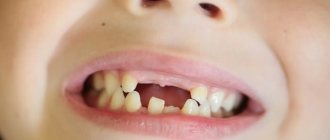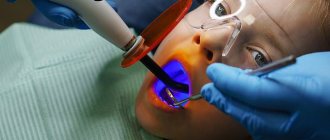From this article you will learn:
- how to silver teeth - photo,
- indications and contraindications for the procedure,
- preparations for silvering teeth in children.
The article was written by a practicing dentist.
Silvering of teeth is a conservative method of treating caries of primary teeth in children, which consists of impregnating the caries-affected areas of the tooth with silver. This method is most often used in children aged 2-3 years, or in children over 3 years old - with a strong fear of the dentist. The method has its drawbacks, and is not indicated for every child, but in some cases it is the only way to do without removing teeth before their physiological change.
In dentistry, the following drugs are usually used to silver baby teeth in children: Saforide or two-component Argenate. The effectiveness of silver plating will largely depend on the stage of the carious process. The method will be especially effective in the initial form of caries in the white spot stage, as well as superficial caries (i.e. in cases where the carious process does not extend beyond the enamel layer). With average caries, when dentin is already damaged, the method has very limited effectiveness.
Teeth after silvering: photo
Silvering of teeth in children can be performed from the moment they erupt (from 6 months), the procedure does not require anesthesia and is well tolerated even by emotionally unbalanced children. The visible disadvantage of the method is the change in the color of the teeth - which must be warned in advance to the child’s parents, having obtained their consent to use the method. In this case, only demineralized areas of tooth enamel affected by caries change their color (the color of healthy enamel does not change).
What is silvering of teeth
Silvering is an old technique that is still used in some dentistry in an attempt to protect baby teeth affected by caries. To do this, the doctor simply covers the infected area of enamel with silver.
Today, the very idea of clogging dangerous microorganisms in tooth tissue under a layer of metal seems strange, but some doctors are still convinced that such a method of combating caries has a place. Why? Because silver has antimicrobial properties.
Indeed, such a film can prevent the development of caries, but only if it is at a very early stage, when the enamel has become loose and bacteria have just begun to colonize its cells. Finding caries in a child at this stage is an almost impossible task, and in other cases, silvering will not only not bring the promised result, but can even cause harm to the teeth.
Silvering of teeth can only be effective when caries is in the white spot stage. Then an antimicrobial film created from metal can really protect tooth tissue from further penetration of microorganisms and destruction of enamel tissue.
Indications and contraindications for the procedure
Like any other medical procedure, silvering of teeth has its own indications and contraindications for use.
This technique is indicated only if caries is detected at the spot stage in a child under 3 years of age.
Silvering has the following contraindications:
- Damage to dentin caries.
- The child has severe somatic diseases.
- The child has allergic reactions to the constituent components of medicinal drugs.
- Age over 3 years, when it is possible to use other methods.
Why is it important to save every baby tooth?
- To protect permanent teeth.
Advanced caries can not only lead to the destruction of milk teeth, but also damage the rudiments of permanent ones. - To form the correct bite.
Early removal of baby teeth will lead to displacement of the dentition, and the permanent bite will be incorrect. - For the health of body systems.
Long-term absence of teeth can lead to disruption of the digestive system, as the child will not be able to chew food well.
Features of the procedure
Silvering teeth in children is not a new thing in dentistry; it has been practiced for several decades. The method is as follows: a solution containing active silver salts is applied to a cleaned surface damaged by caries.
Interacting with enamel particles, the drug forms a film consisting of noble metal phosphates, clogging the dentinal tubules. The surface of the tooth at the site of application of the solution becomes dense, less vulnerable to the negative effects of acids and microorganisms in the oral cavity.
The procedure is indicated in the initial stage of caries development, when the stains on the teeth are white or yellowish. In color and texture they are similar to chalk inclusions. In the case of an advanced form, when the soft tissues of the tooth (pulp) are affected, other treatment methods are used.
How does silvering of teeth occur?
Silver plating is done only on baby teeth. This is an absolutely painless procedure, it takes from 10 minutes to half an hour - it all depends on how many teeth need to be covered.
First, the dentist examines the baby’s oral cavity, then removes plaque from the surface of the infected tooth and applies a composition to the enamel. In fact, for silvering it is not pure silver that is used, but a special solution - silver nitrate. It enters into a chemical reaction and blocks the dentinal tubules, preventing bacteria from accessing them.
Over time, the film deteriorates, so it is recommended to repeat the procedure regularly - at least once every 6 months.
After teeth silvering, their color becomes dark and the smile becomes unaesthetic. That is why this method of combating early-stage caries is not used when it comes to permanent teeth.
Indications
You cannot silver permanent teeth - only baby teeth. The method is justified in the following forms of caries found on the front teeth:
- surface;
- medium (assuming the cavity is shallow and the patient will carefully care for the treated units);
- planar (I mean a defect in which the entire crown or several adjacent teeth are affected);
- circular (dental neck is affected).
It is also recommended to carry out the procedure if the child’s enamel is insufficiently mineralized.
It is not advisable to use silver when working with molars. If they already have holes, only filling will help. This is due to the fact that food particles will constantly accumulate in the chewing teeth, which means that the destructive process will continue.
To silver teeth or not?
Silvering is a painless procedure, but its effect may not only not meet your expectations, but also negatively affect the child’s attitude towards dental treatment.
Firstly, before the procedure, the doctor needs to thoroughly clean the baby’s teeth, and this can frighten him. Secondly, the black color of the enamel will cause psychological discomfort to the baby - he will begin to feel embarrassed about his smile.
In addition, silvering of a tooth with moderate or deep caries can be dangerous. Bacteria remain sealed in the dentinal tubules and actively multiply there, while the enamel darkened due to silver nitrate does not even give parents a chance to notice this process. As a result, caries develops into pulpitis within a few months, and a tooth that could be saved has to be removed.
In addition, during the procedure, the composition may get on the gums. Itching, redness or burns occur in this area, and even an allergic reaction is possible.
Silvering of teeth does not cure, it can only stop the development of caries, but only when it comes to damage to the upper layer of enamel.
Advantages and disadvantages of the technique
To date, the opinions of pediatric dentists regarding the procedure for coating children’s teeth with silver are ambiguous. There are many supporters of this technique, since it has proven its effectiveness for decades. Among them is the famous doctor Komarovsky, who does not exclude silvering as an option for treating the initial manifestations of caries. But there are also its opponents, who point out a number of negative aspects.
Advantages of the procedure:
- the ability to stop the development of the carious process;
- absence of negative reaction from the little patient;
- Silver plating is not contraindicated in young children;
- relatively low cost and accessible to everyone.
Disadvantages of silvering teeth:
- the formation of black plaque on the tooth surface, which looks very unaesthetic;
- It is impossible to use the technique for deep carious processes.
«
It is precisely because of such negative consequences that it is not recommended to silver-plate the front baby teeth in school-age children, since this can cause psychological discomfort in the child and ridicule of classmates.
Which is better: fluoridation or silvering of teeth?
Fluoridation is an alternative to silvering teeth. This is a gentle procedure that strengthens the enamel, making it denser and more reliable. Thanks to this, acids - the main cause of caries - will not be able to damage the strengthened surface of the tooth.
At the same time, fluoridation, like silvering, does not treat teeth and does not relieve them of caries, but it helps prevent infection from penetrating the enamel tissue. In addition, this procedure has a positive effect on its shade - it makes it lighter.
Optimal age for treatment
Doctors advise silvering the teeth of children under three years of age. This is due to the fact that at this age children very often refuse to undergo regular dental treatment and are terrified of drills and other dental instruments.
With children four years old and older, doctors most often manage to come to an agreement. Doctors offer them gentle filling techniques, during which they almost never experience any discomfort. But, if the child is emotionally unstable, the need for silver application may arise even at age five.
What to do to avoid silver teeth
- Visit your pediatric dentist regularly for checkups and learn how to properly and thoroughly brush your teeth.
- Help brush your child's teeth until you are sure that the baby can now handle this task well on his own.
- Regularly undergo professional oral and dental hygiene. Depending on the age of the child, the set of procedures differs, but its main task is to remove all plaque and tartar.
- Carry out fluoridation and remotherapy to strengthen the enamel and protect it from bacteria and acids.
- Seal the fissures of the chewing teeth. This is a safe and painless procedure that will reliably protect against caries.
To silver teeth or not, each parent decides for himself. But when choosing this procedure, it is important to understand that it will not protect the baby’s baby teeth from caries and will not cure them, but on the contrary, it can cause early tooth extraction and the appearance of complexes in the child. Today there are alternative methods of silvering. They are safe, effective and really help prevent the occurrence of caries and its complications. Doctors at the Center for Modern Dentistry clinic daily and successfully use these methods to strengthen and protect your teeth.
Reasons for the development of early childhood caries -
As we said above, any means of treating caries will not be very effective if parents are not ready to implement or control the quality of oral hygiene in the child. It will also not be possible to achieve a positive result if you allow your child to eat between main meals - sweets, flour, starchy foods, drink sweet soda, or sweet or sour juices. Thus, without following a diet and controlling the consumption of easily digestible carbohydrates, the effect of treatment will tend to zero.
Our website has professional reviews on oral hygiene in children that will help you avoid the risk of developing caries in your child altogether. You can write your questions in the comments to this article. And we hope that our article: Silvering teeth for children reviews - was useful to you!
Sources:
1. The author’s higher professional education in dentistry, 2. Based on 20 years of personal experience as a dentist, 3. The European Academy of Paediatric Dentistry (EU), 4. National Library of Medicine (USA), 5. “Pediatric therapeutic dentistry. National leadership" (Leontyev V.K.).
Covering teeth in children: basic methods and their features
Children's teeth are often exposed to such unpleasant and rather dangerous diseases as caries and pulpitis. And not immune from
This is not a single child.
The enamel of a child's tooth is very thin and cannot fully withstand aggressive influences. For example, at night the child ate and fell asleep, and the bacteria ingested with food negatively affect tooth enamel until the morning. This pressure on a child’s teeth over a long period of time causes the development of “bottle caries.” What to do? How to protect your child's teeth? An excellent solution to this problem is offered by dentists at the Beryozka clinic in Balashikha and the medical clinic in Zheleznodorozhny - complete protection of children’s teeth by coating them with special preparations.
Important information about the silver plating procedure
- If caries has managed to overcome the initial stage and is already affecting the dentin, then silvering in this case will be a useless measure. Dentin in children is softer than in adults, and caries develops at twice the rate. When caries has entered the middle stage, even with silvering once a month there is no absolute guarantee that the lesion will not develop into pulpitis. Remember that silver plating is not a panacea! The procedure makes it possible to hold out until the child reaches the age of 3 years in order to carry out full treatment.
- Applying silver to exposed dentin can cause burns to the pulp, which will lead to the development of pulpitis, as the chemicals will be able to easily penetrate the nerve of the tooth. The onset of pulpitis is indicated by severe pain that is difficult to relieve. The doctor performing silvering must accurately calculate the time of application of the solution so as not to damage the pulp.
- Teeth treated with silver change their color, especially if their surface is treated with Russian or Belarusian preparations. The teeth take on a black tint, which looks extremely unaesthetic. Japanese-made solutions also change the color of teeth, but not to black, but to light gray, which is not so noticeable.
Technique of the procedure
The method of silvering has not undergone any changes over a long time. Impregnation of primary teeth is carried out in the following order:
- Selection of the drug. The list of medications used in this method is extensive. The main active ingredient included in the solution is 30% silver nitrate. In addition, you need a special Vaseline-based oil that protects the gum mucosa during processing.
- Cleaning the enamel with brushes and applying abrasive paste. It is performed to free the surface of the tooth from plaque, microorganisms and dead particles.
- Rinsing the mouth from the toothpaste with water.
- Protection from saliva using cotton swabs, drying the mouth with warm air.
- Treating gums with Vaseline oil to prevent burns.
- Applying a solution containing silver using a dental applicator (microbrush). The treatment is carried out locally, avoiding contact of the drug on the gums. After a few minutes, the procedure is repeated, then the reducing agent is applied.
- At the final stage, the silvered surface is dried with warm air. A sign of a correctly performed procedure is the appearance of black enamel at the site where the solution was applied.
It is not recommended to rinse your mouth, eat or drink for 40–60 minutes after treatment.
Additional recommendations and rules
Silvering is a method that stops the development of caries for a short period of time. To protect your child from premature painful treatment or complete tooth extraction, you should follow the rule: the procedure is carried out at the frequency established by the doctor. Before starting the session, you should brush your teeth several times under the supervision of an adult. It is necessary to completely remove plaque from the enamel, even in the most inaccessible places.
If there are pathogenic microorganisms in the oral cavity, then during their vital activity an acid is produced that destroys the applied layer. Therefore, when a child has been ill with a bacterial infectious disease, then 2 weeks after complete recovery you should consult a dentist. In such cases, it is recommended to silver teeth more often.
Today, silvering of teeth is recommended for children with chronic tonsillitis, otitis, inflammation of the adenoids, stomatitis and gastrointestinal problems. A healthy oral cavity is the key to normal microflora of the whole body. And if the tooth enamel is intact and undamaged, then there is no necessary environment for the growth of harmful bacteria, which can cause chronic diseases.
Expert of the article you are reading:
Lozinskaya Alla Nikolaevna
Pediatric dentist, general dentist.
You may also be interested in:
Children's orthodontist Dental treatment for children Correction of bite in children Features of the treatment of childhood caries Treatment of pulpitis of baby teeth Removal of baby teeth Prevention of childhood caries
Show more
Is it possible to do silver plating at home?
At first glance, there is nothing complicated or dangerous in the procedure. But, despite the fact that the child feels calm at home, applying the drug on his own is strictly prohibited, and here’s why:
- It is difficult for a person far from medicine to determine the extent of enamel damage. Penetration of silver solution into soft tissue can lead to pulpitis.
- If silver solution gets on the mucous membrane as a result of inept actions, it causes a burn.
- Without special skills and tools, it is difficult to properly clean the surface of a tooth; unremoved plaque will negate all efforts.
- If an allergic reaction occurs, medical attention may be needed immediately. It is difficult, often impossible, to provide it at home.











